WAN-YU CHEN
2019-2023 SELECTED WORKS



10
Biotech Laboratory
Academic work_SCI-Arc
2022 Spring
Instructor: Elena Manferdini
Partner: Jinxin Xu
Design Development Project
Academic work_SCI-Arc
2022 Fall
Instructor: Herwig Baumgartner, Zach Burns
Consultant: Matthew Melnyk, Sophie Pennetier, Jamey Lyzun
Diamond Ranch Elementary
Academic work_SCI-Arc
2021 Fall Instructor: Marcelyn Gow
Partner: Suyue Jin, Hao
Software: Rhino, Zbrush, Unreal Engine
Teamleader: Wan-Yu Chen, Jinxin Xu
Partner: Alejandro Aguilera, Arjun Bharat, Diba Ghazia, Xiao Jin, Qingyang Zong
42
Solar Carve + The King Fahad National Library
Academic work_SCI-Arc
2021 Fall
Instructor: Randy Jefferson, Dwayne Oyler
Partner: Sizhe Lu, Yiyu Zhou, Arjun Bharat
Software: Rhino
46
Software: Rhino, Cinema 36
A DAY OF DEFAMILIARIZING
Neishi Transit Station
Academic work_Tamkang
2019 Thesis Design
Instructor: Chia-Ju Lin
Software: Rhino, Lumion, Adobe Suite
1:1 Interactive Installation
Academic work_Tamkang
2018 Spring Instructor: Hwai-Wen Chang
Teamleader: Wan-Yu Chen
Partner: Yu-Chuan Hsu, Software: Rhino, Lumion
Elementary School
Arc Gow Hao Wang
Cinema 4D, Maya, Redshift
West 2nd Street Art Museum
Academic work_SCI-Arc
2022 Fall Instructor: Jenny Wu
Partner: Yiyu Zhou
Software: Rhino, Cinema 4D, Redshift
Architecture at Zero 2023 Competition Allensworth
Academic work_SCI-Arc
2023 Spring
Instructor: Ramiro Diaz-Granados
Partner: Yiyu Zhou
Software: Rhino, Twinmotion
Installation
work_Tamkang
Chang
Chen
Hsu, Hao-Jui Peng, Cheng-Wei Wu
Lumion
Kindergarten
Professional work_Trace Architecture Office
2020 Summer
Position: Architectural Designer
Contribution: CD stage of the project (interior, drawings, 3D modeling)
Construction: 2020.12-2022.7
Academic work_SCI-Arc

2022 Spring
Instructor: Elena Manferdini
Partner: Jinxin Xu
Software: Rhino, Zbrush, Unreal Engine

RE: INVENTION biotech focuses on exploring the advanced biotechnology of Anti-aging and decay of human bodies. As a hub of biotechnology, the design redefines the conventional idea of how people approach laboratory spaces by incorporating nature and landscape into the building.
In the future, humanity will overcome most diseases. In return, more people are becoming immobile due to the aging and decay of their bodies. Human society is faced with the question of aging of organs and natural death. The Global Anti-Aging market report and forecast indicate the market’s growing size due to consciousness among consumers regarding their physical appearance. Behind this are the advancements in technology and huge investments in research and development activities.
Climate change, health crisis, scarcity or excess of resources, luxury and poverty, technology and inventions, reinforce the idea that humans are part of a relational ecosystem with other beings, biospheres and environments. In our globalized and hyper-connected world, we are increasingly exposed to complex phenomena and an expanded network of representation. To understand them and to deal with them, we need to manage large quantities and qualities of data. This project investigate possible futures stemming from the current ecological and health challenges, and to expand the role of agency in our architectural creative process.
Design Approach: A.I. GAN Training
The initial ideas and concepts of the project came from A.I. GAN training. To align the possible futures that we imagine, jellyfish, prothesis, and tree barks have been chosen to undergo the A.I. GAN training. And the mixture images that have metallic shells with bulbing and glowing volumes were generated. These images of living and non-living creatures were then used as the inspiration for the building form.


Form finding inspiration generated from A.I. GAN Training
The mixture images that have metallic shells with bulbing and glowing volumes were generated. These images of living and non-living creatures were then used as the inspiration for the building form.







The mass of the building is generated from A.I. GAN training with images of jellyfish, trees, and prostheses for the inspiration of the organic form of architecture.







The bulbing volumes with metallic and transparent material are generated and replaced several major spaces of the originally rectangular mass of the building. They create specific qualities that varieties of programs require inside the building.


The pipes attached throughout the whole building connect all the spaces in the building. Collecting wastewater from laboratories, they form a water circulation system that purifies water and reuses them. The panels on the surface of bulbing volumes constantly are water purifiers. They change colors according to the status of water purification.
Closeup view: pipes and purifiers
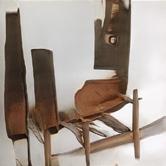





The design is specially composed of Jellyfish and Trees laboratories, theater, two major parliaments, and several circulations which connect them all. Each circulation gives people the freedom to explore the space inside the building. The bulbing volumes with metallic and transparent material are generated and replaced several major spaces of the originally rectangular mass of the building.


To let the public be involved, the main entrance of the building is located at the southwest corner of the building, which is more accessible to the public. The other one is a down-digging space underneath the building, which leads to the forestry at the east that connects to the building. Forestry is part of the tree lab, which serves as the eco landscape. By breeding varieties of trees and vegetation, people can experience a natural forest while circulating up to the inside of the building.
As the heart of the building, the parliaments are used for arranging seminars and summits between scientists and the public. The huge hollow spaces introduce light into it and other spaces in the building. It is also the intersection of all the public circulation.
Parliament atrium
The huge hollow spaces introduce light into it and other spaces in the building. It is also the intersection of all the public circulation.





The Jellyfish lab locates at the upper levels of the building. Its primary research is to do cell research and genetic research of jellyfish. In addition, there are also studies on the extraction of ingredients from various plants (seaweed, coral, bark) that can be used as health or nutritional supplements. Depending on the research project, the shape of the lab is different. Each laboratory has its breeding tank. Jellyfish with varying cycles of life were cultured in other laboratories and tanks.
The aquaculture water will be collected through the pipeline to the ecological pool outside the laboratory towards the forestry and to the underground to form an eco cycling. Filtered water will be reused for culturing trees and jellyfish. Depending on the research project, the shape of the lab is different. Each laboratory has its breeding tank. Jellyfish with varying cycles of life were cultured in other laboratories and tanks. Forestry is part of the tree lab, which serves as the eco landscape. By breeding varieties of trees and vegetation, people can experience a natural forest while circulating up to the inside of the building.


2022 Fall
Instructor: Herwig Baumgartner, Zach Burns
Consultant: Matthew Melnyk, Sophie Pennetier, Jamey Lyzun

Teamleader: Wan-Yu Chen, Jinxin Xu
Partner: Alejandro Aguilera, Arjun Bharat, Diba Ghazia, Xiao Jin, Qingyang Zong
This project investigates issues related to the implementation of design: technology, the use of materials, systems integration, and the archetypal analytical strategies of force, order, and character. The project includes a review of basic and advanced construction methods, analysis of building codes, the design of Structural and Mechanical systems, Environmental systems, Buildings service systems, the development of building materials and the integration of building components and systems. The intent of this project is to develop a cohesive understanding of how architects communicate complex building systems for the built environment and to demonstrate the ability to document a comprehensive architectural project and Stewardship of the Environment based on the previous design project “RE: INVENTION”.
A series of built case studies will be presented by the instructors along with visiting professionals in the field who are exploring new project delivery methods. These case studies will be shown in-depth with construction photographs, 3D renderings, and technical drawings and details.













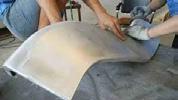




























A - 709





Diamond Ranch High School was established in 1997-1999 to inject more vitality into the community and recruit more students. The studio centers on public education, especially elementary learning. And the project will be Diamond Ranch Arts and Sciences Elementary school. The notion of scalar change focuses on our design from
The reference of this method of close up and zoom out is the movie ‘The Powers of Ten’ created by Charles and Ray Eames in 1977. The intention is to work through
The pedagogical position of this project is to create small learning environments in the school where students reflect on the relationship between people and nature. From a functional point of view, holes of different sizes and walls of varying shape also introduce natural light into the rooms and allow for natural ventilation, which cools down the perennially hot building. The project reflects a belief that architecture should create a connection rather than a separation between people and nature.

The architectural shape of the classroom is designed and developed from the form and concept of the chair. Its unified and clear architectural language can enhance people’s first impression of this school and improve the integrity and harmony of the design.
The design of the chairs came from the iteration of the Thonet chair. The chairs are curved and intrinsic with different pipe widths and deformed into various models, beginning from simple line work. Since chairs are for elementary schools, more vitality is considered to be brought into the site. The chair design exaggerates some features derived from the Thonet chair and transforms the color palette.
With the meandering wall forms and the textures applied to them, the birch bark material creates natural terrain and plant growth qualities. The classroom is the landscape, which blurs the boundary between architecture and nature, allowing natural elements to be introduced into the indoor spaces. This creates the possibility for sunlight, air, and plants in the natural environment to enter the indoor spaces.



To blur the boundary between architecture and nature, the walls consist of tubes with seams. The timber pattern and translucent materials were applied to walls and spaces.


Our site and building are quietly located between the land and the mountains, and the campus has a strong sculptural quality. The free and organic form also shapes the adaptable indoor space comprised of walls, floors, ceilings, flexible interiors, and the landscape of the campus. The design language of meandering, which is driven from the lines, creates an escalating landscape and zoning along with the existing site. These forms allow teachers and students to roam, experience nature, and look at the sky and mountains at any time. They blur the boundary between architecture and nature. The community center locates at the end of the main road of the existing middle school site for public people to access this site. As the building mainly serves students and faculty in the school, the art center and sports stadium are located in the inner part of the site, which nears the sports field. On top of this, the circulation from one building to another was placed created for people to circulate inside the site.






Geometric primitives are the basic shapes we all know and recognize. They are simple three-dimensional forms such as cubes, spheres, cylinders, and cones. One of the
In addition to its formal qualities, we have also been interested in articulating methods of assembly, specifically the operations necessary in connecting and attaching parts in place. We like to imagine that building elements, while sliding, rotating, and clicking into place, may leave traces of their assembly onto the architecture itself.
The project began by using Midjourney as an early exercise to test potential configurations and spatial consequences for a geometric primitive made with interlocking parts. The second half of the semester will situate the primitive in relation to the ground.








In recent years, with the increasing development of AI computing power, AI’s ability to process images has also improved. When a man’s drawing created with Midjourney AI won an award at the Fine Arts Exhibition held at the Colorado State Fair, it caused an uproar not only in the art world but also among the general public. It is undeniable that the use of AI will gradually become part of people’s lives and affect the way creators create their work. AI can produce a series of solutions in a short period of time by interpreting textual narratives and deconstructing and sewing together material from databases. However, if we imagine a 3D spatial relationship based on the 2D images generated by AI, there is an ambiguity in the results generated by AI. This allow people to read the space and the 3D relationship in different ways. This ambiguity is why we should consider AI as a powerful aid to our design and exploration of volumes.
Our design uses two pictures obtained from midjourney and DALL.E 2 as the front and back hemispheres of the sphere puzzle. Using 3D modeling, we explore the relationship between the surface of the spheres and the volumes inside, such as how they connect and pull themselves together to form a sphere. In both midjourney and DALL.E 2 images, the depth and width of the gaps become the basis for cutting the spheres. We imagine the internal relationship of this sphere puzzle by disassembling the puzzle.


We use sequential disassembly to emphasize the narrative of a disassembly process and the spatial relationship between the connected parts of the different pieces. We imagine that this sphere is assembled by 9 pieces of different sizes, and in the process of disassembly, we can find that each piece overlaps and wraps around the previous parts that have not yet been disassembled. At the end of the disassembly, the core part is a key-like block that locks itself to the next piece. In terms of material selection for the physical model, we used clear resin as the core key material and plated copper, nickel, and zinc for the other pieces.
9 pieces that construct the sphere and the base



The sphere is assembled by 9 pieces of different sizes, and in the process of disassembly, we can find that each piece overlaps and wraps around the previous parts that have not yet been disassembled.





Based on the primitive puzzle previously developed, we want to discover the possibility of how the primitive puzzle can be the starting point for a building. By deassembling the primitive into a new posture on a site, the spatial relationship within the sphere puzzle fundamentally disrupts the fit of the parts to its whole and opens up opportunities for the primitive to become architectural - addressing program, structure, spatial sequence, and materiality.





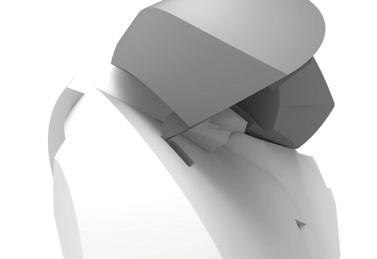

The site of the building is located in the heart of downtown LA, in a nearby open space of The Broad. The site is on a slope with a huge height difference which is a continuous slope all the way up to The Broad. This open space is now used as a parking lot.
As an art museum, we imagine the building and the surrounding landscape are not only an extension of the original museum space of The Broad but also a space that bridges and interlocks the space, people, and the neighborhood and allows them to flow inside. The sphere puzzle was de-assembled by a few moves, such as pulling out and adding pieces, scaling, and rotating before placing it on the site.











The building volumes are mainly divided into two halves placed on the base; they come from the process of decomposition and transformation of the sphere puzzle. The keys in the original plan still function as keys to the two large spatial assemblages in the architectural space. The two keys in the building are the main spaces for changing the flow of people. We tried to preserve the spatial relationship between the different blocks of the original plan in the process of transforming the plan into a building. The transformed building volumes are combined with the newly designed topography to create a gap for people to enter.

Physical models of this project are built in 3/32” = 1’-0” and 1/16” = 1’-0” by 3D printing, to show the detail inside the section and the relationship between building and overall landscape. To showcase the materiality of the design, In terms of material selection for the physical model, becides the spraypaints, copper, nickel, and zinc are are plated on the model.


2023 Spring
Instructor: Ramiro Diaz-Granados
Partner: Yiyu Zhou
Software: Rhino, Twinmotion
As a TAC teaching and innovation farm lab, the project is an architectural relief package delivered to the site and unpacked with an initial provisional status about its context, program, and users, which changes over time. This dual nature can be considered a mutual assemblage and characterized as a kind of parallel computing design strategy that addresses a set of mutual concerns by working in parallel on two different configurations.
Allensworth lies in the Central Valley of California, one of the most productive agricultural regions on the planet, providing more than half of the fruits, vegetables, and nuts grown in the United States. More than 7 million acres (28,000 km 2 ) of the valley are irrigated via an extensive system of reservoirs and canals. Farmers and farmworkers are the cornerstones of the larger food sector, which includes the industries that provide farmers with fertilizer and equipment; farms to produce crops and livestock; and industries that process, transport, and distribute food to consumers. Despite the dominance of agriculture in the area, Allensworth and many communities in the Central Valley are food “deserts” with no place for residents to purchase fresh food and vegetables.
This project aims to connect the farm lab to its aspiration to become a destination for sustainable agriculture.
The array is structured in two phases, and the gantry is the way to move the program space volumes. We adopt the local climate, farming, and people activity schedule as the basis for placing each activity space on the base in volume.


Initially, the entire design will arrive at the site in a complete package. Then the packages will be opened up and placed on the site and become the paving. Then, the amenities and spaces that need to be accessed by local people will be placed on the base in the first phase. In the second phase, the remaining programs related to the school will be incorporated into the stack and arrayed on the base according to the climate and academic schedule of the school. This stack and array routine is a 2-year cycle.
In order to transform Allensworth into a suitable land for planting in the long run, water, and soil purification is one of the main considerations in our design. There are two types of greenhouses, one that can be moved on the site and one that is fixed to the site.


In this relief package, the gantry plays an important role. We reimagined a gantry as a beast and character that remain after construction and participate in the overall assemblage over time. Just like oxen strapped to a cart, it is like a Beast performing work by stacking and arraying the program space volume around the site to reform the landscape. It contains effective infrastructure (elevators, stairs, energy) but also be designed as characters that bring delight and affection.
By utilizing the industrial gantry as a base model, we will convert them into beasts/ characters by AI text-to-image generators and 3D model them. In addition to performing construction work, as well as other seasonal performances within the assemblage, it has water storage and a greenhouse embedded and serves as an overview point for the Allensworth.

The gantry contains water bag to store the water and greenhoouse. The horn of the gantry can slide to the side of the stack and serves as elevator for the people to circulate inside the stack.

Academic work_SCI-Arc

2021 Fall
Instructor: Randy Jefferson, Dwayne Oyler
Partner: Sizhe Lu, Yiyu Zhou, Arjun Bharat
Software: Rhino
Tectonics, as “ the science of the art of construction,” is a study of the use and artistic design. This project is a study about combining two different façade systems by conducting precedent research, analysis, and precedent transformation.
Solar Carve was the precedent that we studied. The goal for this project is not only about adding the exterior facade system from our precedent but also about bringing some exciting changes to our previous design.

For the process of our façade deformation, we focused on adding additional material to this plain glass overlap, which is cohesive and furthers the façade shading system. The concept is driven by the façade system employed in the King Fahad National Library, Saudi Arabia. The facade consists of a similar repeating three-dimensional pattern system of stretched membrane fabric as the Solar Carve has. The fabric is made of a PES (Polyester) material that allows it to be stretched to a high degree along two axes and gives rise to a shading system that can be easily customized to the desired angle. This shading system is an extension that could be added to the existing façade, making it ideal to be incorporated into our building.

The membrane is an irregular symmetrical hexagon. Those six points on the membrane will attach to the point on the 6” steel tube. To saddle the tension cable for the tensegrity structure, the tensegrity structure is applied to stabilize all the 6” Steel Tubes on the facade. And the bracket slotted connection for those tubes is on the same level as the floor (or they have a mullion close to it). For those tubes that are not, they are connected by saddle tension cable. The saddle tension cable system could be divided into outer and inner ones. The outer one is constructed in a diamond shape. And the inner one is crossed in the back of the membrane fabric sheet, held by fabric connectors and cable connectors. This will double-secure the stability of the entire structure.







ADAVANCED MATERIALS AND TECTONICS FINAL AS3200
Assignment 1.2 - Applied secondary structure to original Solar Carve parimary structure
Overall building chunk and tectonic breakdown
ADAVANCED MATERIALS AND TECTONICS FINAL AS3200
Assignment 1.2 - Applied secondary structure to original Solar Carve parimary structure
Overall building chunk and tectonic breakdown
Primary Structure + Secondary Structure: Solar Carve + The King Fahad National Library
Primary Structure + Secondary Structure: Solar Carve + The King Fahad National Library





ADAVANCED MATERIALS AND TECTONICS FINAL AS3200
ADAVANCED MATERIALS AND TECTONICS FINAL AS3200









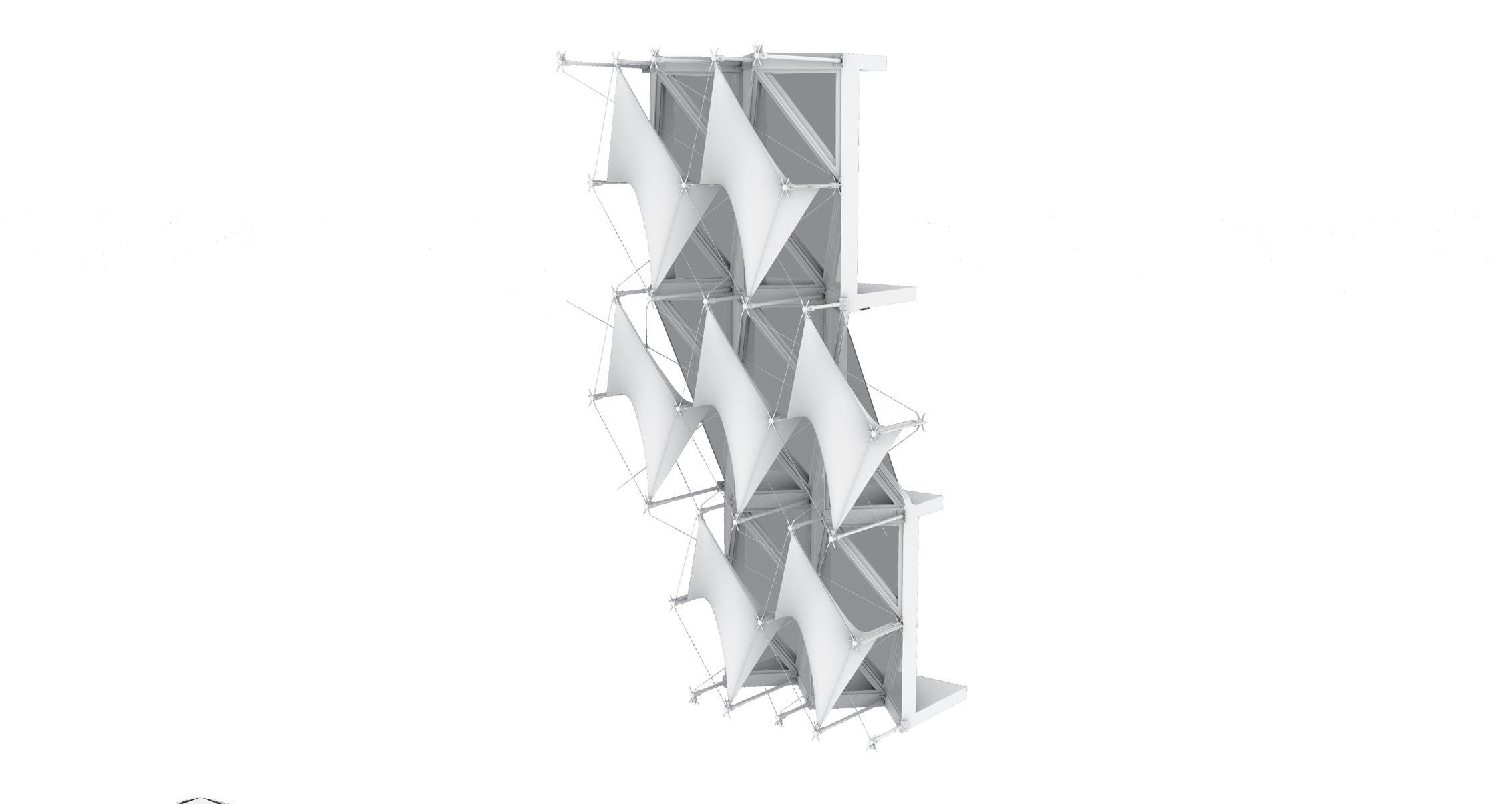
Assignment 1.2 - Applied secondary structure to original Solar Carve parimary structure


Inner saddle tension cable connection detail
Primary Structure + Secondary Structure: Solar Carve + The King Fahad National Library






In modern society, people’s lives are restrained by families, friends, and work. People live monotony lives subject to time. People are used to finishing tasks quickly, fulfilling their free time, replying, and receiving information immediately. People nowadays often overlook the good things in life.

This project is a reflection of monotonous life in a fast-moving modern society. By integrating the feeling of speed and time elapsing, people will perceive different heights and distances on the horizontal site. The vertical tower form of the transit station will make people rethink the question, “How do we experience time?” and have an opportunity to get rid of the monotony of life.
As a container for change in the external environment, the architecture makes time perceivable. As time goes by, the atmosphere of the space will change the way we understand the space.


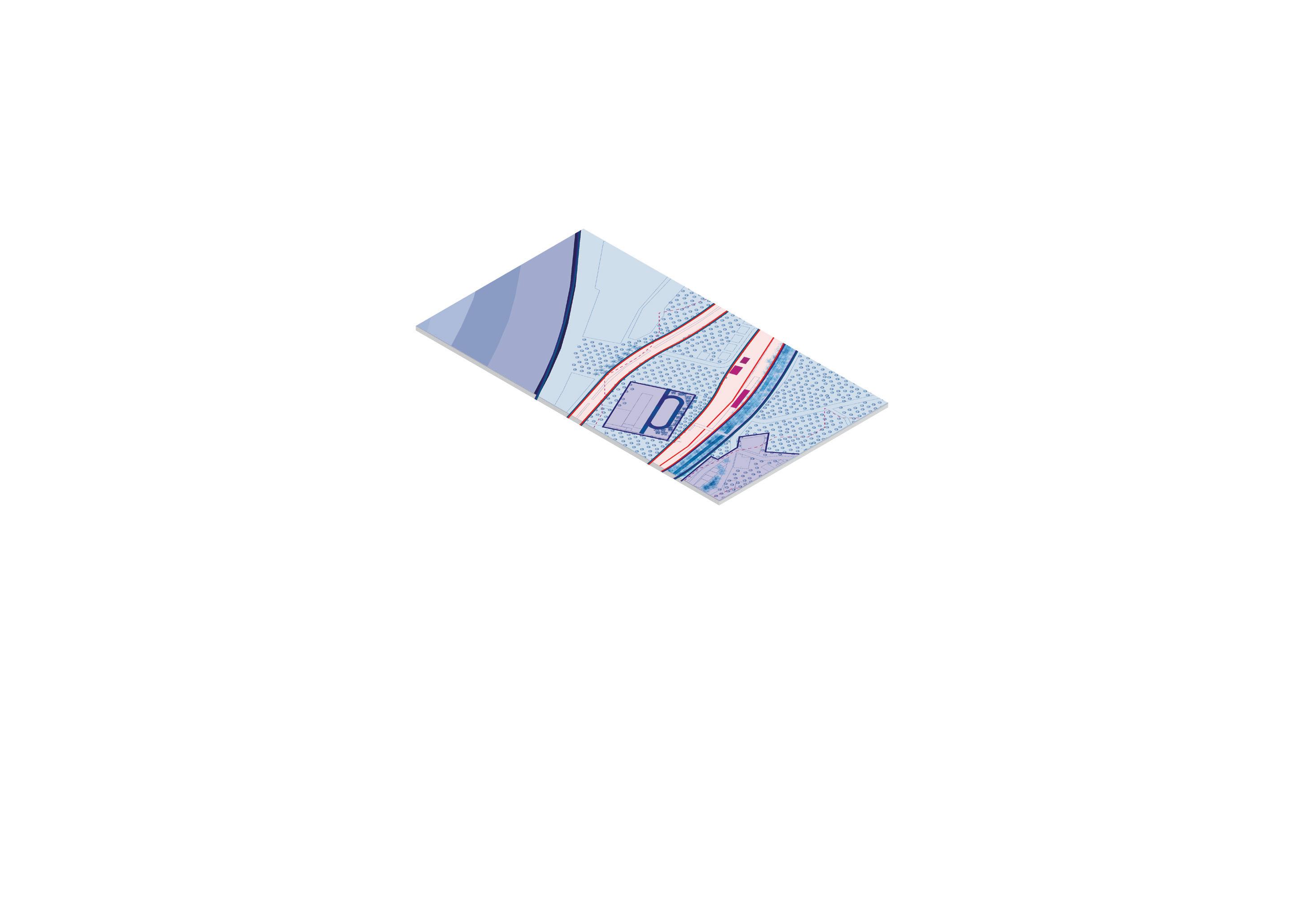








Station, a node of the transportation network, is a part of most people’s life. People go to work and travel to other places from stations. Timetable in the station organizes not only train schedules but also the interval time people wait for trains to make stations operate quickly and efficiently. It is a combination of speed and efficiency.


Surrounded by the blue sea of Taiwan Strait, endless mango fields, and beautiful starry nights of southern Taiwan, it seems to be a totally different feeling in Neishi station. Neishi station is in Pingdong, the south of Taiwan. Only one train will stop here every day. As a result, less than one person is getting on and off every day on average. Unlike other stations, Neishi station seems to have nothing to do with time, speed, and efficiency like any other station.
With the implementation of the Hengchun Sightseeing Railway Project, Neishi Station will become a transfer station for the railway, sightseeing train, and bus in 2024. It will be known as a transit point across Taiwan for passengers who want to go to Kenting.




This new transfer station proposal looks forward to providing people with opportunities to get rid of inertial life. People can get involved in the slow pace of Neishi and choose to experience travel and life in different ways while they are waiting for trains rather than ignoring the beautiful things around them when they pass by in a rush.




Closeup view: pipes and purifiers






The pipes attached throughout the whole building connect all the spaces in the building. The water purifiers change colors according to the status of water purification.
























The implementation of the transfer station, while bringing tourists to the Neishi, also destroys the originally slow and lonely pace. When society continues to develop, people become numb to the chase of time. In a fast-moving life, people gradually forget, “How do we experience time?”











































































































The new design of the transfer station proposes the possibility of redefining programs with time for the reconstruction of the station. The transfer station integrates speeds people would perceive at different heights and distances on the site with the form of a tower. The tower consists of a space with programs that intersect into a path to the top. People would slowly establish a dialogue with the external environment and time to extend people’s perception of time and speed as they climb up through space and activities (auditorium, Seaview library, swimming pool, mango shaved ice shop, and capsule hotels).






























































Because of Hengchun Sightseeing Railway Project, the volume of the station building will become much more significant than now anyway. Making the station building taller instead allows the building to become be a vertical container that integrates different kinds of speed on the field. A taller tower could also create a dialogue with the platform. The passengers’ feeling of various distances and different heights to the building could provoke passengers’ curiosity about the tower and the external environment during the transfer. Besides, it creates opportunities for passengers to get out of monotonous life.
The concept of the tower can be described in the drawing below. The triangles are the platforms of three different transportation systems, and the thick dotted line is the primary path for people to transfer from the platform to the tower. In addition to the primary path, there are trails where people can explore the site next to each platform. Both roads allow people to reach the transfer tower, and the passenger can take either one as their will. The tower is divided into two parts. The outer part is the space for exploring the natural scenery of the site, and the inner part is the hall of the transfer station, connecting platforms.


Height & Sight analysis
Observer’s sight and feel of speed according to various distances and different heights.
Perception of speed
P1: Windows at different heights show a different sense of speed.
P2: Layers of speed intersected by people’s perspectives of view.


P3: Tall volume creates ample opportunities for light in different angles.

2018 Spring
Instructor: Hwai-Wen Chang
Teamleader: Wan-Yu Chen
Partner: Yu-Chuan Hsu, Hao-Jui Peng, Cheng-Wei Wu
Software: Rhino, Lumion

The wind is an invisible presence. It always seems to be around. But it has a far relationship between our culture and life. Blue dye is an old Hakka art that has gradually disappeared. The time-consuming and complex but elegant dyeing methods are becoming less known...
Hsinchu City is the settlement cluster of Hakka culture, and it is also a windy city that blows strong winds because of its special landscape. This project is to build a microarchitecture that has such special humanities with natural factors and revives blue dye with the wind.



Wind Indigo Dye is an architecture that can capture the shape of the wind. The wind is an unlimited resource and the memory of the people who live in Hsinchu. We hope that people can have brand new learning of the Hakka culture by dyeing their own Wind Indigo Dye. The analysis shows that the wind in Hsinchu is constantly blowing in different directions, especially from the North-East. To access the wind from different directions, the microarchitecture should be designed into a radial form. To make the invisible wind into a physical movement, we made a wind panel as a unit to study how to perform wind action. The diagram shows that the wind panel unit, which drives the movement of the drip tube, makes the dripping of dye turn into different patterns due to the different wind forces.


Professional work_Trace Architecture Office
2020 Summer
Position: Architectural Designer
Contribution: CD stage of the project (interior, drawings, 3D modeling)
Construction: 2020.12-2022.7
Located in Haikou, Hainan, China, the campus includes primary school, kindergarten and dormitory buildings, with a total floor area of 64,700 square meters. This is TAO’s second educational project in Haikou, which is another creative practice of exploring links between education and architecture with respect of local context.

The site is located in Jiangdong New District, east coast area of Haikou. The design regards the campus as a miniature garden city, responding to the surrounding environment in an organic form. The building integrates with the surrounding countryside area, green space, river, wetland and ocean, being part of a unified whole.
Meanwhile, the free curves, vivid colors and poetic spaces, which echo the unique childlike innocence and playfulness, are aimed to evoke children’s imagination and creativity, making students a unique school experience.

The kindergarten design creates a looped circulation, providing a platform for children to run. Continuous ramps connect different elevations, and the roof becomes an extension of the ground. The middle layer is elevated to release more semi-outdoor activity space for shade and rain, and at the same time, it is a positive response to Hainan’s tropical climate. Children can run from the ground to the sky, from indoors to outdoors, and grow up free.



